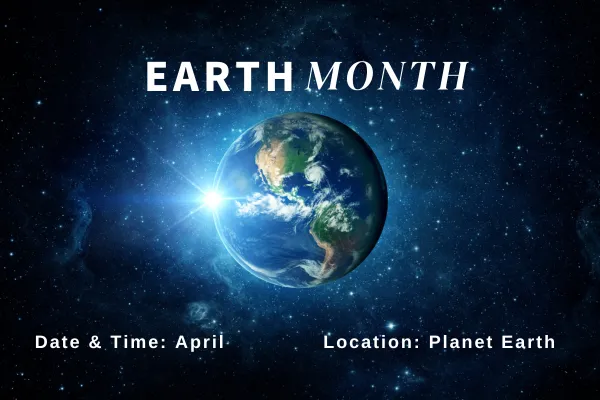My mission is to support:
Your wellness
& sustainability journey
through inspired action.
Welcome! Here you will discover positive choices we can make in sustainability and wellness in our personal lives. I share about low and no-cost strategies, my favorite products and services, and motivation around our actions. Our small actions can make a massive difference when added together!
Now where to get started...
Ready to dive in and explore sustainability and wellness topics?
Looking for solutions for something specific?
To discover recommended resources including books, guidelines and certification programs visit here:
Have we met yet? Let me introduce myself...
Recent Posts:

Celebrating Earth Month: 30 Days of Action
This page includes affiliate links, where I earn from qualifying purchases.
We are entering one of my favorite times of year! I am hearing the soundtrack of birdsong in the morning and spring peepers in the evening. The first sign of color is making its appearance as the early spring native perennials like lupine are sprouting in the garden. Each April we can join the global initiative and participate in Earth Month. If you are searching for ways to live a greener life and to make a difference in the world, below are 30 ideas for celebrating Earth Month.
Calculate your carbon footprint with a tool like this one from the U.S. EPA. Once you have a baseline you can understand how to reduce your carbon footprint.
Watch documentaries like Breaking Boundaries, Plastic Earth, & Kiss the Ground to continue educating yourself on environmental concerns and solutions.

Participate in a clean up event like Take 3 or Clean Earth Challenge. You can take part in these initiatives on your own time as an individual. Post your collections on social media to raise awareness of environmental pollution and to encourage others to take action. Even my own back yard is a work in progress, where I collect trash like this...
Schedule an energy audit by starting with a phone call to your local utility company. Whether you own or rent your home you may find rebates and incentives for energy improvements.
Reduce energy use at home or in the workplace. You can start with simple, low-tech strategies. For example, a fixed awning can minimize heat gain by shading a window or door opening by blocking direct sunlight on a hot summer day. Or you could install a solar shade on the interior, which still allows some visibility to the outdoors but greatly reduces solar heat gain to a space.

Seek to purchase local goods on your shopping trips. Whether you are out buying groceries or updating your wardrobe, keep an eye out for locally made and locally grown options. These items can help reduce your household carbon footprint since they do not have to travel far and wide to land in your cart.
Replace single-use plastics. Stash dedicated utensils for your packed lunch, or if eating on the go. Opt for reusable sandwich and snack bags to reduce plastic waste. Bring reusable produce bags for grocery store purchases and trips to a farmers market.

When making a purchase look to minimize packaging. Prioritize package-free or compostable options.
Avoid unnecessary use of fossil fuels. This could mean evaluating the setpoints of your heating or cooling system or minimizing vehicle idling.
Request a quote for green power. Maybe you’ve thought of installing solar panels at your home or place of business. As we move toward electric vehicles I believe it’s important to power them with green energy. What better way than from our own driveways?

Plan a native perennial garden to install at home, at work, or in your community. Designate an area of lawn to convert to a native wildflower meadow. Keep in mind ways to design color and food availability throughout the season. Prepare to plant a keystone species. You can use this tool to assess how many caterpillar species are supported for moths and butterflies. Plant for specialist species too, like the monarch butterfly. It’s host plant is milkweed, meaning it will only lay its eggs on milkweed which will feed its caterpillars. Specialist species require specific plants to sustain their next generation.
Switch to organic lawn and garden care methods and avoid pesticides. Consider a soil test to understand your lawns nutrient needs.
Dive deeper into environmental solutions through books. For everyday green living topics see Attainable Sustainable by Kris Bordessa. For ecological gardening, check out The Living Landscape by Rick Darke and Doug Tallamy. Or for reducing waste read Zero Waste Home by Bea Johnson.

Optimize your driving for fuel efficiency. Fueleconomy.gov stated that “gas mileage usually decreases rapidly at speeds above 50 mph. You can assume that each 5 mph you drive over 50 mph is like paying an additional $0.24 per gallon for gas.” The impact of driving speed versus fuel efficiency was estimated in a study by Oak Ridge National Laboratory.
Carpool or use alternate modes of transportation. Getting on foot or bike is a great way to add movement to our days. A win-win!
Prepare your organic vegetable garden. You can plan it out now, or plant if it’s warm enough where you are. Did you know that the USDA issued a revised Plant Hardiness Zone Map? You can check it out here.

Install nesting and roosting boxes for birds, bats, or bees. Get familiar with which species like to visit your yard and learn what size and location they prefer. For example, bluebirds like to nest in a box that faces east and that overlooks an open area.
Help conserve dark skies by minimizing exterior lighting. Avoid dusk to dawn sensors, which emit light at unnecessary times. Instead, aim for motion sensors that turn off within a few minutes. Use shielded lights that do not shine upward. This helps prevent skyglow. Using a bulb with a warm hue is less disruptive to nocturnal creatures.
You might be in spring cleaning mode this month. I know I am! As you prepare to part with some items find ways to avoid the landfill. How can they be repurposed before being thrown away? For items that can’t be accepted at donation centers you’ll be surprised by what can be rehomed when posting as free to online marketplaces. Magazines can be used in art therapy programs. Surplus construction supplies or tools may be accepted by Habitat for Humanity. Seek a new home for the things you no longer need.

Learn how to compost and return that nutrients to the soil. You can store acceptable food scraps in a countertop bin, and add them to your outdoor compost bin to feed your future gardens.
Join a green team for your town, workplace, or school. Or start one! We can all share ideas and offer a helping hand to achieve green initiatives outside of our own homes.
Make a donation to a nonprofit focused on environmental stewardship. Find the cause you are passionate about and help fund their projects. This could be an organization in your local town, or on the other side of the globe.

Install various water sources for wildlife using dishes of different depths and heights from the ground. Toads and frogs may seek out dishes on the ground. Butterflies will drink from puddling dishes where they can obtain minerals from wet soil. Meanwhile, some birds will only like to drink from moving or misting water.
Be mindful of indoor water use. Are the flow rates of your fixtures considered water efficient? Look for WaterSense labels when updating fixtures.
Seeks ways to minimize exterior water use, such as xeriscaping techniques. Overhead irrigation can quickly evaporate. Use more efficient methods like drip-irrigation if watering your garden is necessary. Install drought-tolerant plants with mulch to retain moisture.
Volunteer your time to help with a local environmental initiative. This is a great way to make new friendships and be inspired by those making a difference where we live. This can also help educate us on our local environmental priorities.

Get to know your neighbors…not just the human ones, but also the non-human ones too :) Download apps like iNaturalist, which can help you identify native and invasive plant species, or various pollinators and wildlife. Want to learn bird calls? Try the birdNET or Merlin Bird ID apps to get to know what species are in your area, and how to best support them.
Complete regular mechanical system maintenance so that systems can run efficiently. You can start by replacing common air filters, whether that’s for a system in your home or for your vehicle.
Manage invasive species on your property or help with a local project. Get familiar with which species are most problematic in your area. Many state environmental departments offer fact sheets to educate on invasive species management.
Reflect on the year ahead and make a list of projects that you’d like to carry forward beyond Earth Month! Let this April be your springboard to living a greener life.

I hope these ideas spark excitement about all the ways we can participate in Earth Month and throughout the year! Consider creating a calendar to set yourself up for success. Which idea do you want to take action on first?
I am so grateful to live on this beautiful planet surrounded by the amazing cycles of Mother Nature and all the forms of life on Earth. I am grateful to each of you who are trying to make a positive impact on this world. Together, our intentional efforts are making a difference for a sustainable future. Wishing you a Happy Earth Month!
PS: Grab your free Guide to Sustainable Living: 11 Ways to Make a Difference. Click here!
Copyright 2023 Beth Manteuffel All rights reserved




